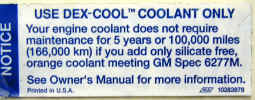 |
|
5 years or 100,000 miles? |
Perhaps one of the most important elements in your cooling system is the coolant. It needs to be clean, non corrosive, non conductive and have freezing and boiling properties that are appropriate for the conditions. Rule of thumb is to change the coolant every two years. Some cars are coming equipped from the factory with so called "extended-life" coolants. One of the more popular extended life coolants is Dex-cool.
The "recommended" service intervals of Dex-cool coolant is 5 years 100K miles and in some cases 150K miles. These extended service intervals have not proven to be any thing but trouble for the consumer. In some cars, the coolant tends to turn to a thick, gooey, sticky, muddy, gritty, orange corrosive gel that fouls the radiator, heater, plugs coolant passages in the intake manifold and heads, and many times starves the water pump, resulting in overheating, and leaking. Mounting evidence suggests that Dex-cool reacts with plastic sealing surfaces, allowing leakage at the intake manifold gaskets. The best thing to do without voiding any warranty, is to change your coolant every two years with the recommended coolant. CHANGE THE COOLANT EVERY TWO YEARS!! ESPECIALLY IF IT DEX-COOL!! DEX-COOL IS THE WORST OFFENDER. DEX-COOL DOES NOT LAST 5 YEARS OR 1000,000 MILES*. Dex-cool pictures
General Motors introduced Dex-Cool to certain lines of vehicles in 1996. Since it was formulated without the addition of silicates (the corrosion inhibitors in green antifreeze) a different corrosion inhibitor strategy was needed. Organic Acid Technology or OAT is the inhibitor part of dex-cool. Unfortunately, the dex-cool is capable a rather nasty breakdown. The residue it leaves behind is very sticky, and likes to find areas in the engine and other areas to "drop out" or "fall out " of solution and stick to the wall surface of engine and radiator. If the residue is in the radiator, hoses, or recovery bottle, it's relatively easy to clean and remove the debris. When the residue is in the heads and block, only a chemical flush will remove this orange mud. In some cases, the orange mud hardens, and seems to expand or push the gasketed surfaces out of position, causing leaks.
There are some in the industry (including GM) that claim that exposure to "air" causes the Dex-cool to come apart, and that faulty radiator cap design is the culprit. They say that with a faulty cap, the cooling systems allow evaporation, allowing the Dex-cool to destabilize, weaken, and lose it's already marginal protection, and then turn muddy. Others say that poor cylinder head design traps air in pockets, allows condensation and ultimately dilution, resulting in aluminum oxide formation and deposits. Neither of these theories completely explain the whole picture, and these are not a universally shared opinions. If air were the culprit, all Dex-cool systems in every vehicle with a recovery (overflow) container would suffer the same problem. They don't. Reverse flow V-8's would be immune. They aren't.
Most insulting about the whole issue is the GM dealer response to the problem. While the vehicle is still in warranty - turn a blind eye. Yet once the vehicle has gone past the warranty period, the solution is simple: replace the radiator, hoses, intake manifold gaskets and maybe the water pump. I believe it is this response that has spawned the current class action litigation.
There are about 72 brands of coolant on the market today. 95% of all these coolants are manufactured using ethylene glycol and mixed with 50% water when installed in a car or truck. Dex-cool is no exception. The differences between coolant brands comes from the additives that enhance the corrosion protection properties. For years this protection came from silicates, but more recently coolant manufactures have moved away from silicate enhanced coolant, to OAT enhanced coolant. Silicates are discussed more here.
Organic Acid Technology refers to the type of corrosion and rust inhibitors used in the make up of the coolant. OAT formulated coolants provide "background" or reserve protection (works like a vitamin), and as such, tend to react more slowly to situation changes as opposed to the faster acting silicates (works like an aspirin). There are several ingredients that constitute the OAT, including carboxyl, benzoate, borate, triazole, and 2-ethylhexanoic acid. Depending on the brand of coolant, these ingredients may vary. Vehicle manufactures increasingly are moving to OAT coolant, and may have slightly different formulations for different markets. European vehicles have used OAT formulated coolant with an addition of some low level silicates to provide further and faster protection. These are called hybrid inhibitor coolants because they contain both silicates, and OAT formulations. More discussion on coolant, inhibitors, and silicates are discussed here.
Dex-cool manufactures continue to insist that Dex-cool will last 5 years and 150,000 miles, and that the problem is lack of maintenance. In other words, you should be maintaining your maintenance free cooling system.
The bottom line. There are lots of coolants out there. Lots of inhibitors out there. Lots of cars out there. Only certain cars have thick, gooey, sticky, gritty, muddy corrosive gel fouling their cooling system, causing overheating and leaking.
 |
Call it what you
want.
We call it Dex-cool. |
Ford doesn't like Dex-cool |